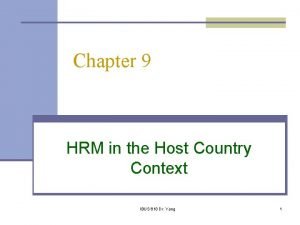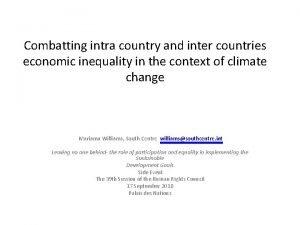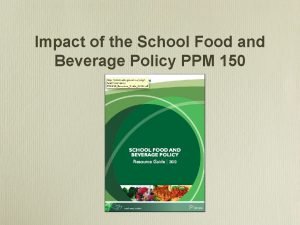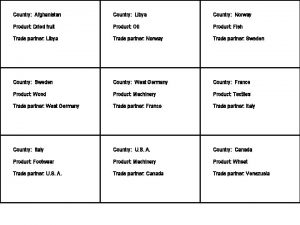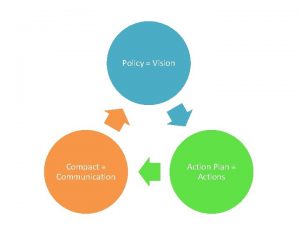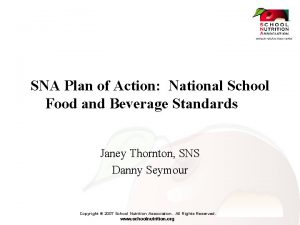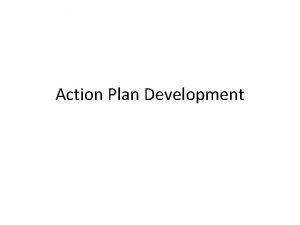National Food Policy Plan of Action and Country












- Slides: 12

National Food Policy Plan of Action and Country Investment Plan Monitoring Report 2012 An overview by Ciro Fiorillo, CTA NFPCSP August 13 th 2012 National Food Policy Capacity Strengthening Programme

The framework for food security interventions: the National Food Policy and its Plan of Action Bangladesh has been an early adopter of the comprehensive approach to food security through the formulation of the National Food Policy (2006) and its Plan of Action (2008) To reduce undernourishment, stunting and underweight, food should be available, accessible and complemented by nutrition interventions Availability Access Nutrition The National Food Policy Plan of Action provides a comprehensive long-term (2008 -2015) framework for: - Coordinating government interventions on food security - Aligning development support to national priorities in line with the Paris Declaration on Aid Effectiveness - Regularly monitoring progress toward food security in line with MDG 1 -Identifying needs for investments

The framework for food security interventions: The Country Investment Plan Responding to L’Aquila Initiative and in line with the 5 Principles agreed in the Rome Food Summit, the CIP was approved in 2010 and revised in 2011 based on extensive consultations. Ø It is a coherent set of 12 strategic priority investment programmes allowing to coordinate Government and Development partners interventions Ø It is aligned with MDG 1, NFP Po. A and the Sixth Five Year Plan ØIt focuses on investments included in the Annual Development Budget The CIP and Po. A provide the framework for monitoring impacts, outputs and financial commitments

Monitoring the CIP and NFP Po. A A complex exercise involving multiple: - agencies from government and development partners - Levels of monitoring and types of information CIP Results Chain Go. B / donor financial commitments to ongoing (≈ 269) and pipeline (≈ 130) projects INPUTS/ACTION LEVEL 300 action/ strategic actions lines Aggregate outputs Sub-outputs 40 priority investment area 12 CIP programmes OUTPUTS 26 Po. A Areas of Intervention 3 CIP components IMPACTS/OUTCOMES 3 NFP Objectives NFP Po. A results chain NFP Global Objective to ensure sustained food security for all people of the country at all times

National Food Policy – progress toward the goal Overall goals of the NFP is “to ensure dependable sustained food security for all people of the country at all times” In the CIP, 3 indicators focus on nutrition as food security outcome: v Target at reach for underweight and stunting, acceleration needed for undernourishment (for which limited data are available) SFYP indicator and NFP goal Undernourishment Prevalence of underweight children (0 to 59 months WHO standards) Stunting (0 -59 months) 2007/08 2008/09 2009/10 2010/11 26. 8% (2005 -7) 26. 3% (2006 -8) 25. 8% (2007 -9) na 41% na na 36% Target 2015 Source 19% (MDG -1) 33% (MDG -1) FAO SOFI BDHS 38% 43% na na 41% (revised HPNSDP target for 2016) BDHS

CIP indicators included in the Sixth Five Year Plan v In addition to underweight, 4 indicators from the CIP and Po. A were included in the Development Result Framework of the SFYP to measure progress on poverty and food security v Progress against targets is satisfactory SFYP indicator and NFP 2007/08 2008/09 goal (Po. A baseline) Poverty headcount 40. 1% na index (CBN upper (2005) poverty line) Rate of growth of 3. 00% 3. 97% agricultural GDP in constant prices Government spending Na 2. 25% on social protection as % of GDP Growth of wages in kg of rice (3 -year moving average) -8. 11% -1. 38% 2009/10 (CIP/SFYP baseline) 2010/11 Target 2015 31. 5% (2010) na 29. 7% 29% (MDG 1) BBS 5. 24% 5. 0% 4. 3% BBS 2. 52% 2. 64% (revised) 2. 0% 3. 0% Mo. F 7. 16% ≥ GDP growth + 0. 5 BBS and DAM 5. 71% 7. 73% Source

CIP financial commitments (CIP table 4. 1) Variations in CIP Budget between June 2010 and June 2011 v. Total value of the CIP has increased by US$ 947 million (+11. 6%) v. Financed CIP project increased by US$ M 2, 170 (+71%) of which US$ 1, 713 by Go. B (+109%) and US$ 457 by DPs (+31%) v. Pipeline decreased by US$ M 1, 222 (-24%) due to: - Projects whose implementation started (e. g. NNS: US$M 115) - Possible under-reporting of projects in pipelines CIP budget 2011 Revised (data up to June 2010) Financed (ongoing or Pipeline completed) projects CIP programme Total CIP GOB DPs Total Priority A = D+E Availability Access Utilization Total 4, 175 3, 241 778 B C 706 860 8 D 580 878 33 8, 194 1, 574 1, 491 286 738 41 065 E 1, 889 1, 502 37 3, 128 F 2, 889 1, 93 7 84 5, 465 CIP budget 2012 (data up to June 2011) Financed (ongoing Pipeline or completed) projects Total CIP GOB DPs Total Priority A = D+E 1, 9 5 3, 5 5 1 1 B C 5, 11 1, 829 664 3, 55 1, 392 012 47 66 272 9, 14 3, 287 948 D 493 1, 405 E 2, 622 2, 151 338 1, 235 133 5, 906 F 2, 1, 24 95 00 3, 19

CIP delivery and financing progress in 2010/11 - Delivery stands at US$ M 836 (this is CIP execution in FY 2011) - Additional financing US$ M 2, 170 (US$M 1, 861 for new projects) - Additional financing larger than delivery, especially for availability - Develop capacity to deliver - Scale up identification & financing in areas lagging behind Delivery Financing for new projects 1, 200 900 800 DPs 600 Go. B 400 million USD 1, 000 DPs 600 Go. B 300 200 - Availability Access Utilization

NFP Objective 1: Availability of food • Agricultural GDP growth (5. 24%) is above the target for 2011 • Variability of rice production remained low • Rice import dependency slightly increased due to public imports for stabilizing domestic supply and price • Increased share of rice on total food VA: no progress in diversification Indicator Rate of growth of agricultural GDP (in constant prices) Instability of rice production (de-trended 10 y coeff. of variation) Rice import dependency (3 -year moving average) Share of rice value added in total food value added in current price 2007/08 2008/09 2009/10 2010/11 Target 3. 00% 3. 97% 5. 24% 5% 4. 09% 3. 69% 4. 07% 3. 38% na 2. 40% 4. 30% 1. 40% 2. 50% 0% 41. 5% 43. 1% 42. 2% 42. 9%p na ü Scale up fisheries, livestock and horticulture investments to promote diversification ü Foster research and extension for climate change adaptation ü Valorize unused land in costal areas ü Promote use efficiency and quality of agrochemicals ü Promote water use efficiency and preserve water table

NFP Objective 2: Access to food • Poverty rate declined steeply – and the average poor person is less poor • Real wages increased significantly (in rice terms) • Food prices have risen faster than other prices, trend reverted in 2012 Indicator Moderate poverty (CBN upper line) Extreme poverty (CBN lower line) Poverty gap (CBN upper line) Change in wages in kg of rice (3 -y moving av. ) Inflation differential between food and general CPI 2007/08 2008/09 2009/10 na na na. na -8. 11% -1. 38% 5. 1% 6. 3% 40% (2005) 25. 1% (2005) 9. 0% (2005) (av. 2005 -08) (av. 2006 -09) 2010/11 Target 31. 50% 29% (2010) 17. 6% (2010) 6. 5% (MDG 1) na 8% Source BBS BBS (2010) (MDG 1) 5. 71% 7. 73% 7. 16% BBS and DAM 7. 6% 9. 1% 0% BBS (av. 2007 -10) (av. 2008 -11) ü Expand storage capacity; integrate procurement, distribution and trade policies ü Sustain attention to climate change, access to natural resources, price volatility ü Continue regular monitoring of food security ü Finalize the national social protection strategy based on broad based consultations

NFP Objective 3: Food utilisation for nutrition • • Diversification: low in production, improved in consumption (but still > 60% ) Good improvement in CED of women (health intervention impacts) Children receiving acceptable diet reduced (new WHO definition in 2010/11) Consuming of iodized salt reduced (higher standards, informal imports) Indicator Nat. Dietary Energy Supply from cereals National Dietary Energy Intake from cereals Chronic Energy Deficiency among women (BMI <18. 5) % of children receiving minimum acceptable diet (6 -23 months) Households consuming iodized salt 2007/08 78. 1% (2005 -07) 2008/09 2009/10 2010/11 na na 60% 73% na 70% 60% na Target 38% (2004) 32% (2005) 33% (2007) 25% (2010) 20% by 2015 42% 34% 38% 21% 52% by 2016 na 91. 8%% 92% 84% 100% ü Increase dietary diversification & Promote food fortification ü Strengthen community based nutrition ü Improve institutional setup for multi-sectoral coordination ü Develop food safety and quality control and enforce existing legislation ü Assure water and sanitation, especially in urban areas and during disasters

Thank You For comments and suggestions please e-mail: ciro. fiorillo@fao. org dgfpmu@fd. gov. bd
 Host country and home country
Host country and home country Trgpol
Trgpol National action plan for senior citizens
National action plan for senior citizens Cbrn national action plan philippines
Cbrn national action plan philippines Copd national action plan
Copd national action plan Intra country vs inter country
Intra country vs inter country Unit 2 food food food
Unit 2 food food food Sequence of food chain
Sequence of food chain National child policy 1974
National child policy 1974 Panda is national animal of which country
Panda is national animal of which country School food and beverage policy
School food and beverage policy National zoo policy
National zoo policy Child rights act 2005 images
Child rights act 2005 images
